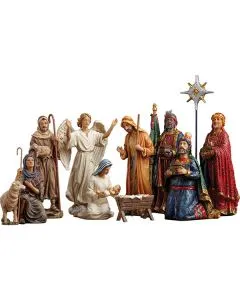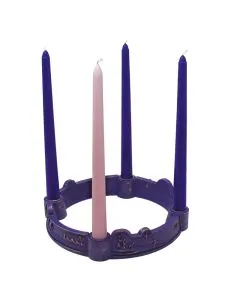All About Advent: Traditions that Put Jesus at the Center of the Christmas Season
From Thanksgiving to January, we can become overwhelmed with the busyness of Christmas preparations and too easily forget the reason for the season: the birth of our beloved Lord and Savior, Jesus Christ.
If you are eager to make Christ’s birth the focus of Christmas festivities from the very start of the holidays ,it may be time to refresh your celebration of Advent.
In many Catholic families, Advent is the centerpiece of the season’s activities. Here’s why: No matter how active our days become as we move closer to His birthday, celebrating Advent gives us an opportunity to pause and reflect on God’s amazing grace and love. Participating in Advent is a daily reminder that “For this is how God loved the world: he gave his only Son, so that everyone who believes in him may not perish but may have eternal life.” (John 3:16)
However, everyone may not be familiar with Advent traditions. That’s why this blog post, the first in a series, will answer the most common questions about Advent. Throughout the season the posts will dive deeper into everything covered here. We hope you bookmark them so you have a handy Advent resource.
Let’s begin.
Why do we celebrate Advent?
Advent cuts through the noise of Christmas commercialization and helps us put our focus squarely where it should be: on the coming of Our Lord and Savior Jesus Christ. It gives us an opportunity to appreciate the true spirit of the season by building our anticipation of His Birth. With Advent, we enrich our Christmas celebration by taking the time to celebrate His coming throughout the season.
Learn more about the history of Advent.
What are some fun facts about Advent?
- The word “Advent” is derived from the Latin word “adventus.” This means “the coming.”
- It is the beginning of the liturgical year, that’s like a New Year’s celebration for the church.
- Advent began as a season of fasting in preparation to baptize converts, according to the Catholic Education Resource Center.
- Many Catholics use Advent as a time to contemplate the Second Coming of Christ, in addition to His birth.
- The Advent wreath, which is one of the most popular Advent traditions, has Northern European pre-Christian origins which were adapted by Christians. By 1600, Christians established formal Advent wreath practices.
Find out more about how to celebrate Advent.
What are the symbols of Advent?
Advent is rife with powerful symbolism. This guides us through the themes of the season and reminds us to keep Jesus at the center of our Christmas preparations. Here’s a little bit about each of the most common symbols:
The color violet. While people associated Christmas with red and green, it’s actually violet that colors the Advent season. While it symbolizes repentance and fasting, violet also signifies the anticipation and excitement that precedes the King, and is the color of royalty and sovereignty.
The Advent wreath. The Advent wreath is a meaningful way for your family to mark the progress of the season by lighting one candle each Sunday. The shape of the wreath and its components each signifies an aspect of God’s promises to us.
The Advent candles. Each week of Advent, a candle is lit, until all four are glowing come Christmas Day. Likewise, as we personally move closer to Jesus, our world becomes brighter. Each Advent candle has a special meaning:
- The first candle symbolizes our hope which comes from God’s promises.
- The second candle reminds us to prepare for the Lord.
- The third candle represents the joy that Jesus brings to us.
- The fourth candle represents the love of the angels who announced the good news.
The Advent calendar. An Advent calendar captures our excitement as we move closer to Christ’s birth. It provides an opportunity to mark each day, typically by pulling open a window to reveal a special illustration, as we move through the Advent season.
The Jesse Tree. Follow Christ’s lineage with a Jesse Tree, which illustrates the people, prophesy and events leading up to His birth. The Jesse Tree is named after the father of King David and references Isaiah 11:1:
“A shoot will spring from the stock of Jesse, a new shoot will grow from his roots.”
The Nativity. These are a depiction of Christ’s birth. Nativities may honor the intimacy of just Mary, Jesus and Joseph at the manger, or depict a glorious celebration replete with angels, wise men, children and animals.
Get more details about Advent’s symbolism.

What are the Weekly Themes of Advent?
Each week of Advent represents our growing faith that Jesus is coming. It moves from hope to celebration.
The First Week of Advent begins with Advent Sunday which includes a special church service and prayers focused on hope. There may be an invitation to set aside time to celebrate the coming of our Lord and know that when we reach out to Him, He will lead us through the darkness.
You may want to meditate on this verse:
“Many peoples will come to it and say, 'Come, let us go up to the mountain of Yahweh, to the house of the God of Jacob that he may teach us his ways so that we may walk in his paths.' For the Law will issue from Zion and the word of Yahweh from Jerusalem.” (Isaiah 2:3)
You also may want to bring a little light to the world by doing an act of kindness for a stranger. For instance, you could begin an Advent box. Every day of Advent, place a toiletry or nonperishable food item inside it. On Christmas Eve day, deliver it to a homeless shelter or food shelf.
The Second Week of Advent calls us to prepare for the coming of the Lord. This is the time to ask God for His help to make our lives more centered on His teachings.
You may want to meditate on these verses:
"As it is written in the book of the sayings of Isaiah the prophet: A voice of one that cries in the desert: Prepare a way for the Lord, make his paths straight! Let every valley be filled in, every mountain and hill be levelled, winding ways be straightened and rough roads made smooth,and all humanity will see the salvation of God." (Luke 3:4-6)
To celebrate this second week, you may want to visit someone in a nursing home or volunteer at a food shelf or soup kitchen. This activity recalls Matthew 25:40:
“And the King will answer, ‘In truth I tell you, in so far as you did this to one of the least of these brothers of mine, you did it to me.’”
The Third Week of Advent is known as Gaudete Sunday. This is when Advent transforms from hope and preparation to celebration. Gaudete means “rejoice” in Latin. The spirit of the Advent celebration lightens and this may be why the color of the third candle on the Advent wreath shifts from purple to rose.
You may want to meditate on these verses:
“Always be joyful, then, in the Lord; I repeat, be joyful. Let your good sense be obvious to everybody. The Lord is near. Never worry about anything; but tell God all your desires of every kind in prayer and petition shot through with gratitude.” (Philippians 4:4-6)
To honor the third week, you may want to give a homemade gift to a friend to share the joy of the season.
The Fourth Week of Advent. This last Sunday before Christmas we prepare for the Good News. We focus on the signs of that Jesus is soon to arrive.
You may want to meditate on this verse:
“The Lord will give you a sign in any case: It is this: the young woman is with child and will give birth to a son whom she will call Emmanuel.” (Isaiah 7:14)
To recognize this fourth week, you may want to pay special attention to how God is moving in your life, and discuss this with a friend. Also, let God use you to show His goodness to others by delivering the Advent basket you started four weeks ago.
Remember, this post is just a brief overview of the Advent season; it’s deeply immersed in tradition. That’s why books have been written on the subject. Here is one you may want to reference:
- Advent and Christmas Wisdom from Pope Francis - Be inspired by the example of Pope Francis as he models the humility and generosity of our Savior. Reflect on the pope`s teachings, accompanied by Scripture, prayer, and action. Then go out and share the message: Jesus Christ is born!
We hope you now have solid starting point to help you put the birth of Jesus at the center of your life throughout the Christmas season. Is there anything else you’d like to know regarding Advent? Let us know in the comments, and we’ll do our best to follow up.


